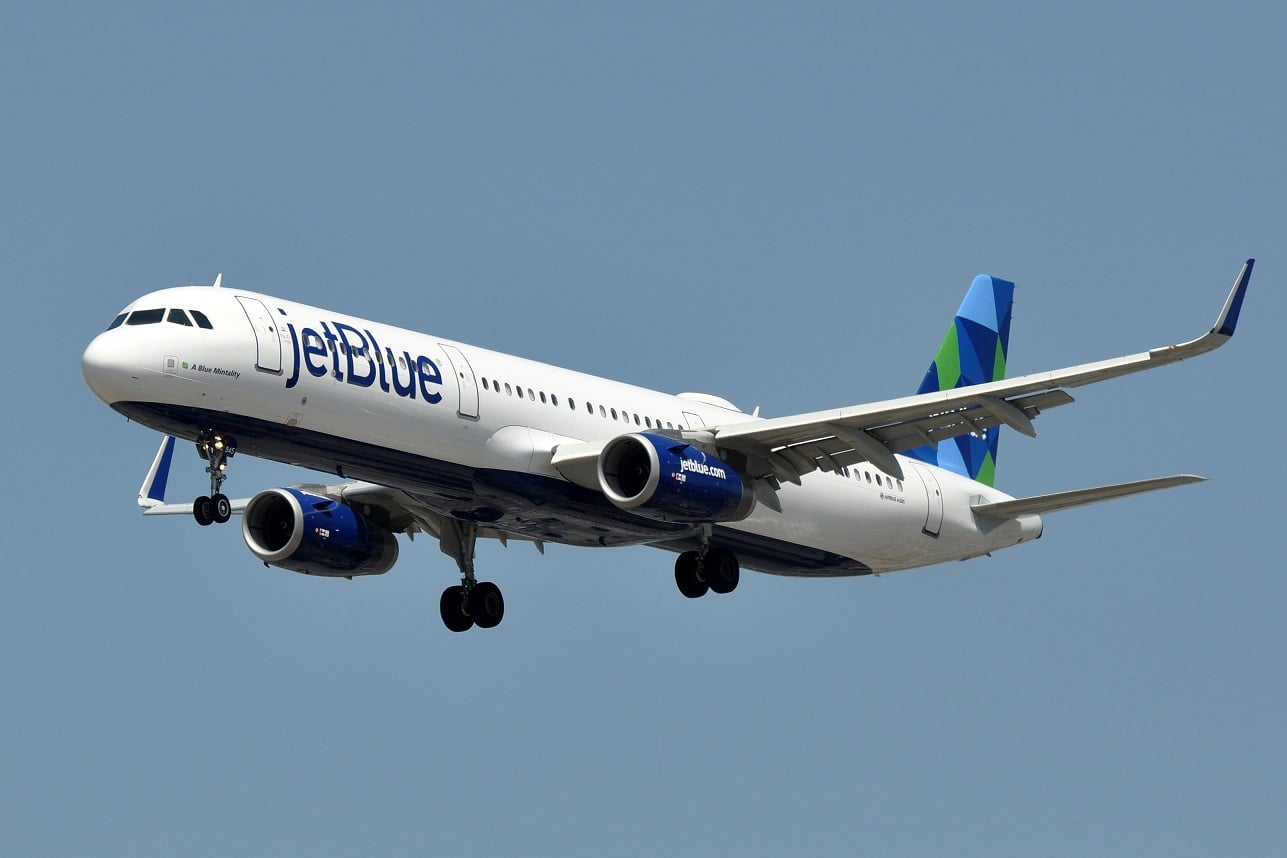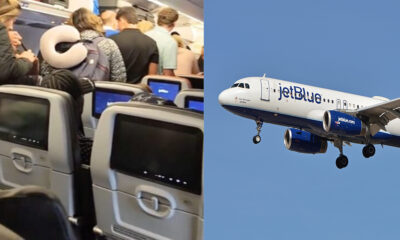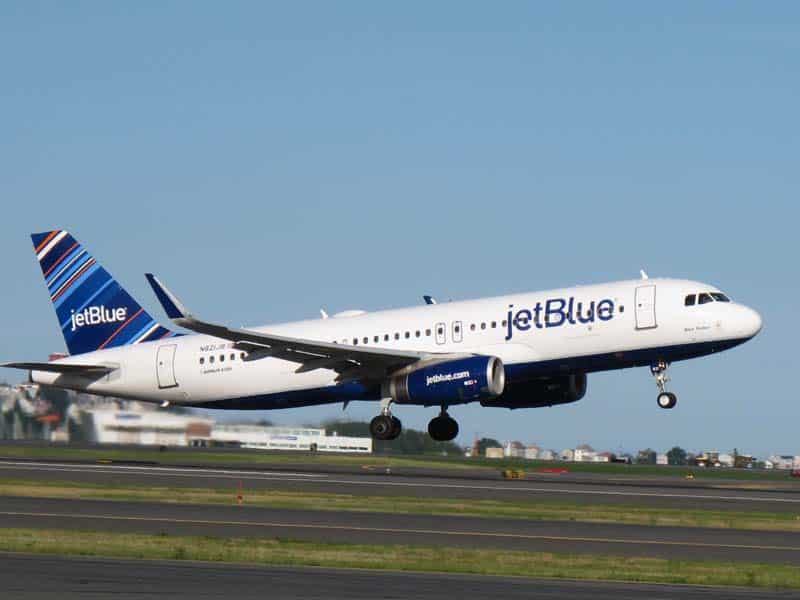Airlines
JetBlue Sets Plan for 200 Daily Flights at Orlando International Airport

JetBlue announced new nonstop service between Orlando International Airport (MCO) and two top Caribbean destinations, as the airline unveils new plans to bring more low-fare, high-quality flights to Central Florida. Launching in November 2023 and out for sale today, JetBlue will fly from Orlando to Punta Cana, Dominican Republic and Santiago, Dominican Republic (a). After its planned combination with Spirit, JetBlue expects to reach 200 flights a day in Orlando by 2027.
Since Orlando became a JetBlue focus city 15 years ago, customers across Central Florida have embraced JetBlue’s compelling offering of low fares and a much-loved experience, including the most legroom in coach (b), free seatback entertainment, free Fly-Fi high-speed internet (c), free snacks, and friendly service.
The planned combination of JetBlue and Spirit will unlock long-term growth opportunities that would not be possible otherwise, delivering JetBlue’s low-fare, customer-friendly experience on more routes and increasing options in and out of Central Florida. This includes introducing new nonstop service to a number of destinations that would not be viable today. In total, JetBlue would offer flights to approximately 20 markets that are not served by either JetBlue or Spirit from Orlando today and would increase flight frequencies on approximately 25 additional routes. With its increased footprint and relevance in Orlando, JetBlue would also introduce its game-changing Mint premium experience, further raising the bar on transcontinental flights.
JetBlue and spirit responded to the filing of a complaint by DOJ(Opens in a new browser tab)
JetBlue estimates its plan would add approximately 350 incremental new airport jobs in the airline’s Orlando operations, while also supporting increased economic activity across the region that is anticipated to lead to further job growth. In addition, JetBlue’s no furlough policy ensures that current Spirit team members who wish to stay with the combined airline will have a role with JetBlue.
Connecting Orlando to Popular Caribbean Destinations
JetBlue’s new flights connecting Orlando to Punta Cana, Dominican Republic and Santiago, Dominican Republic will offer customers in Central Florida more choices for leisure travel and furthers JetBlue’s significant presence across Latin America and the Caribbean. JetBlue will also become the only airline to serve Santiago with nonstop service from Orlando.
New, year-round service between Orlando and Punta Cana, Dominican Republic and Santiago, Dominican Republic will take off in November 2023. Seats are out for sale starting today with fares as low as $123.
Daily Schedule between Orlando (MCO) and Punta Cana (PUJ)
Beginning November 4, 2023
|
MCO – PUJ Flight #1077 |
PUJ – MCO Flight #1078 |
|
8:35 a.m. – 12:05 p.m. |
1:10 p.m. – 3:00 p.m. |
Daily Schedule between Orlando (MCO) and Santiago (STI)
Beginning November 4, 2023
|
MCO – STI Flight #1265 |
STI – MCO Flight #1266 |
|
1:00 p.m. – 4:20 p.m. |
5:30 p.m. – 7:10 p.m. |

Airlines
A software error caused grounding the entire airline fleet

On Wednesday, the U.S. Federal Aviation Administration (FAA) issued a ground stop advisory for all Alaska Airlines and subcarrier flights due to a software issue, disrupting travel plans for passengers.
The FAA directive, which prohibited the departure of Alaska Airlines mainline and subcarrier flights, was implemented as a precautionary measure following the detection of the software problem. The ground stop was initiated after Alaska Airlines encountered difficulties during a system upgrade related to the calculation of weight and balance for their flights.
As a result, the airline opted for a temporary suspension of all its operations to address the issue and ensure passenger safety. Alaska Airlines promptly issued a statement acknowledging the incident and expressing their commitment to resolving the matter swiftly. “This morning we experienced an issue while performing an upgrade to the system that calculates our weight and balance.
Out of an abundance of caution, we requested a ground stop for all Alaska and Horizon flights, which was instituted at approximately 7:30 a.m. PT,” the statement read. Passengers affected by the disruption voiced their concerns on social media platforms, prompting Alaska Airlines to reassure them of their efforts to minimize the inconvenience and expedite the resumption of flights.
Following approximately an hour-long interruption, the FAA lifted the ground stop order, allowing Alaska Airlines and its subcarriers to resume normal operations. However, it was clarified that SkyWest, which provides regional service for Alaska Airlines and other carriers, was exempt from the ground stop and continued its flights unaffected.
Aerospace
Which is bigger 777x or 787 aircraft ?

The 777X is a new series of the Boeing 777 family and is designed to be larger and more efficient than its predecessor. It features two variants: the 777-8 and the 777-9, being the larger of the two.
The Boeing 777X emerges as the larger sibling within the Boeing family, representing a significant leap forward in both size and efficiency. Comprising two variants, the 777-8 and the 777-9, the latter takes the crown as the larger of the two. With its expansive fuselage and impressive wingspan, the 777X is tailored for long-range journeys and boasts a substantial passenger capacity.
On the other hand, the Boeing 787, affectionately known as the Dreamliner, occupies a niche in the market as a smaller yet formidable aircraft designed for medium to long-range flights. Its distinguishing feature lies in its composite fuselage, a technological marvel that renders it lighter and more fuel-efficient compared to conventional aluminum counterparts. The Boeing 777X is larger than the Boeing 787 aircraft.
When it comes to passenger capacity, the 777-9 reigns supreme, typically accommodating a sizeable contingent of 400-425 passengers in its standard configuration. In contrast, the 787, with its more modest dimensions, typically carries between 240-290 passengers, depending on the variant and layout.
One of the remarkable innovations introduced with the 777X is its folding wingtips, a feature designed to address the logistical challenges of accommodating such a large aircraft in conventional airport gates. These folding wingtips enable the 777X to retract its wings, allowing it to fit into gates designed for smaller aircraft while still reaping the benefits of an extended wingspan during flight, thereby enhancing fuel efficiency and operational flexibility
Airlines
Why Don’t Airplanes Fly Over the Pacific Ocean?

Flights do indeed fly over the Pacific Ocean, but the routes they take are often determined by factors such as airline policies, air traffic control decisions, and weather conditions. The Pacific Ocean is one of the largest bodies of water on Earth, and it’s regularly crossed by numerous flights traveling between North America, Asia, Australia, and other destinations.
However, some specific routes might avoid flying directly over certain parts of the Pacific Ocean for various reasons. For example:
- Safety and emergency considerations: While modern aircraft are equipped with advanced safety features, airlines, and pilots may prefer routes that keep them closer to potential diversion airports or within range of search and rescue facilities in case of emergencies.
- Air traffic control restrictions: Airspace management authorities may impose certain restrictions or preferred routes for managing air traffic efficiently. These restrictions could be based on factors such as military operations, airspace congestion, or diplomatic considerations.
- Weather conditions: Pilots and airlines consider weather patterns when planning routes. While the Pacific Ocean generally experiences fewer weather-related disruptions compared to other regions, factors like turbulence, thunderstorms, or tropical cyclones can influence route selection.
- Managing Cost Factors: In route planning, airlines have to take fuel prices, maintenance costs, crew charges, and other operating costs into account. Direct routes over the Pacific Ocean may be more cost-effective for shorter distances, but they may also necessitate extra safety precautions, including carrying more fuel for longer overwater operations.
- Remote Locations and Navigational Challenges: The Pacific Ocean’s vastness poses navigational issues, particularly for aircraft operating over isolated regions with few ground-based navigational aids. For precise positioning and route direction, pilots must mostly rely on satellite-based technology and onboard navigation systems, which may necessitate additional training and equipment purchases.
- Lack of Suitable Landing Options in the Pacific Ocean: Unlike regions with dense air traffic and numerous airports, the Pacific Ocean has vast stretches of open water with few suitable landing options in case of emergencies. While long-range aircraft are equipped with safety features like life rafts and emergency locator transmitters, the lack of nearby airports can increase the time it takes for rescue and recovery operations to reach distressed aircraft, posing additional risks to passengers and crew. Therefore, flight routes may be planned to ensure proximity to potential diversion airports or alternate landing sites in case of unforeseen circumstances.























